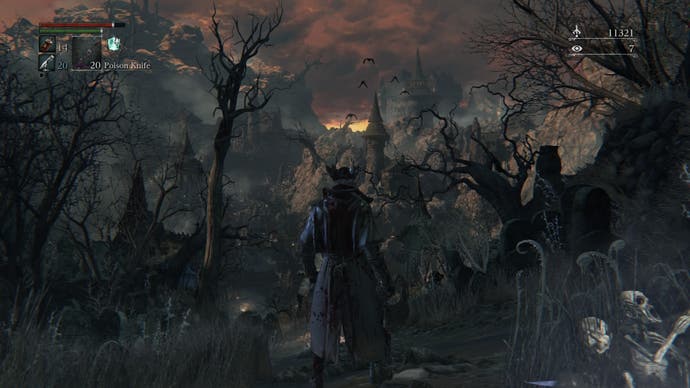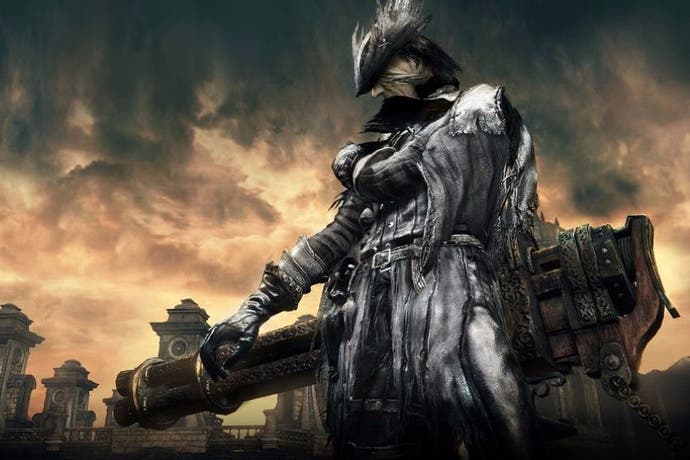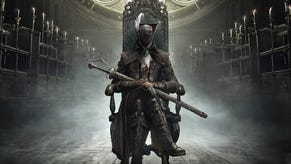Is Bloodborne the best game ever, or just the second best?
Early impressions of the PS4 exclusive ahead of our review.
Editor's note: This is an early impressions piece, based on four days' play with Bloodborne. We'll be posting our final review later this week, once we've experienced the game on fully stressed online servers and once we've been able to spend a little more time in Yharnam.
Created by Japanese developer From Software and directed by Hidetaka Miyazaki, Demon's and Dark Souls are two of the best games ever made - and for me Dark Souls is the greatest of all. These games re-imagined and revitalised the role-playing game from first principles, moving away from the genre's tired tropes and placing the emphasis firmly on the player's intelligence, perseverance and skill. They are games that treat the player like an adult, and so the satisfaction in progressing through their incredible worlds is simply unmatched.
It has been three-and-a-half years since the release of Dark Souls. And in that time Hidetaka Miyazaki and From Software's A-team have been developing Bloodborne. In the age of teasers for teasers, countless countdowns, and previews and leaks galore, the best thing about Bloodborne is that you don't really know anything about it. Be wary of reading too much before that disc is safely in the PS4's tray. These impressions will not ruin anything at all: I'll write generally about the design and impact of what From Software has achieved, but ruin no surprises. A big part of Bloodborne's magic - and Souls aficionados will be familiar with the feeling - is the thrill of discovery.
I've been playing Bloodborne solidly for four days and barely scratched the surface. What a game. It shares the foundation of the Souls games and without doubt could be one of them, but this is only the start. Several aspects carry over wholesale under new names: now you collect blood echoes by defeating enemies rather than souls, and dying works similarly except you're 'awakening' afresh each time rather than undead. The basic movement of your avatar, outside combat, is identical. The inventory system's more or less the same. But these commonalities are layered atop a very different beast.
The biggest changes, and the least obvious at first, are to the combat system. Your avatar is usually carrying a gun in the left hand and a 'trick weapon' in the right, the latter so-named because each has two forms that can be switched between at rest or mid-combo. The one everyone's already seen is a handled saw that can be used for quick gouges, or flipped open into a longer scythe-like blade which has more range and does more damage but takes longer to swing. R1 and R2 are light and heavy attacks respectively, while L1 changes the weapon's form - so run up to an enemy and press R1 for a fast swipe, then press L1, and you'll deliver a second blow but the weapon will change mid-swing into the scythe form. This combo is your bread-and-butter switch, and good enough to dispatch weaker enemies, but it's the absolute baseline.

Pressing L1 again after the second attack, for example, will result in another swipe that morphs the weapon back to the saw form. So it's possible to hit an enemy with the saw, switch your next hit into a scythe attack, then switch back into the saw for the final blow before you hop away. The difference in speed between the trick weapons' two forms, where one is always much faster than the other, also becomes a part of later enemy designs - one example can change stances if you're using the heavy weapon too much, becoming a faster and more agile threat capable of landing hits before you do. This sounds complex, but the execution is much more about keeping a cool head and picking the right moment to switch than having demon fingers.
The other offensive factor is your gun: at the start there's a choice of a pistol or shotgun, but later there are all sorts of goodies. While the trick weapons are where damage and crowd control is coming from, the firearm is the finesse that ties everything together. Though it inflicts damage, which can be decent with the appropriate stats, the gun's role is stunning enemies - and for 'stun' read 'parry.' Time a shot just before an enemy's blow lands and you'll knock them to their knees, ready for a brutal riposte attack that, as far as I can gather, involves your hunter thrusting a hand into their chest and exploding something therein. It's pretty spectacular, not to mention satisfying. And the other side to this mechanic, quite a beautiful touch, is that if your timing is too early the shot will usually delay the incoming attack just long enough for you to dodge - which both helps you learn timings, and stops the precision inherent in the system from being too punishing.
The biggest issue most players will have with this - at first - is that the gun replaces the shield. Somewhere in Bloodborne's opening few hours you might happen across a wooden shield item, but it's hard to see this as anything other than a cruel joke: in this world you either learn to dodge, or you die. Though I'm 100 per cent in favour of the new combat system, for reasons we'll go into below, I'm slightly ambivalent about how it will work for new players. I was able to adjust relatively easily because I've played so much Souls I understand the basics of combat and how From Software's enemies tend to work. But at the same time my first playthrough of Demon's Souls was spent walking around with the biggest shield I could find, permanently raised, poking at enemies from behind it. These days I can dual-wield or greatsword it with the best, but a shield was how I learned to play.
Still, let's not overstate this because there's a good reason behind what has been lost. The whole ethos of combat in Bloodborne is different from Souls. The latter games excel at interplay - balancing defence and offence, requiring you to switch between the two at the right moment or break the cycle with parries. Bloodborne is all offence. The hunter is capable of ripping apart enemies, and even engaging groups, in a way that the Souls protagonists never were. You don't have a shield because frankly it wouldn't fit - this protagonist is all about pressure and staying on the attack regardless of what the enemies are doing.

The sheer power of the various trick weapons, and the ability to bring out your damage-dealer mid-combo, is one part of this. But the most crucial mechanics in making it work are the gun, healing and a new style of dodging. The gun speaks for itself - always accessible, capable of isolating one incoming enemy and stunning them for the riposte, as well as wearing down foes at distance. The healing comes into play when you're hit - the portion of your health removed turns orange and stays that way for a few seconds. In this brief window you can regain that health by attacking the enemy that dealt damage. My instinctive reaction after getting hit in a Souls game is to roll away, a stubborn part of muscle memory, whereas Bloodborne almost forces you to double-down and return any damage received with interest. It makes maintaining a continuous assault, even under serious damage, a real option.
These are great systems, but the dodging is nothing less than genius. The traditional roll dodge is still the default move assigned to the circle button. But when locked-on to an enemy, this becomes a whooshing sidestep worthy of the Flash that has a much lower recovery window - obviously each individual move takes stamina, so there's a limit, but you can zip back and forth multiple times in an instant. This single move changes everything. Not only is it possible to dance with larger enemies and bosses, landing hits while alternating position second-by-second as their blows rain down, but now you can close gaps incredibly quickly and, when things are getting too hairy, be out of the danger zone instantly. With groups of weaker enemies it allows you to control distance effectively and focus on one or two at a time. It is a tool of supreme utility and, in concert with the gun and healing mechanic, what allows Bloodborne's fights to be so much more hectic without losing the omnipresent danger that is such a big part of Souls combat - mess it up, and you'll die as easily as ever.
This system is eased in gently: the enemies for Bloodborne's first part are humans and werewolves that, while perfectly capable of killing you, don't quite go for the throat in the way that later foes do. Once out of the initial areas you start encountering things that hit hard and have a huge number of possible attacks, many more than in the Souls games, making the fights both fast and brutal. Bloodborne feels more unforgiving than Dark Souls (!), and there are some hair-tearing engagements, but this is the price of your avatar having much greater capabilities.
It almost goes without saying that, in a game directed by Hidetaka Miyazaki, this change in mechanics is matched by a change in theme. Bloodborne's world is gothic majesty crossed with Victorian technology, but shot through with a medieval disregard for bodies: the aesthetics of an abattoir. Saws separating flesh from bone, flayed skin as decoration, limbs severed or distended, and of course scarlet nectar over all. During fights each wound brings forth great spurts of blood and, when critical blows land, these become crimson explosions that colour the hunter's garb. After a good exploration session you're covered head-to-toe in the lifeblood of your foes, a mute testament to skill and ruthlessness that you're almost sad to lose on awakening.

It is something of a miracle that, while there's plenty of viscera flying around, you wouldn't really call Bloodborne gory. It's more unsettling than that, and this is another big thematic shift. Bloodborne is a horror game. Remember the Tower of Latria in Demon's Souls? Of course you do. Not only do bells return as something of an overarching metaphor within the world, but there are enemies and locations here that bear comparison - and some frankly terrifying jump scares. I played one section with a friend who was desperate to get a look before release and, despite my being in control, when a certain enemy first appeared we both physically jolted in our chairs.
This combination of butcher shop and hieratic architecture is only one part of Bloodborne's world, and to go over the others would risk spoiling some wonderful treats unnecessarily - fair warning though, I'll go into more detail in the full review at the end of this week. What can be said in a more general sense is that these are some of the greatest environments From Software has ever produced, and the incoherence of Dark Souls 2 is a distant memory. What becomes increasingly evident about Bloodborne is the scale, with the city of Yarnham opening up in a manner reminiscent of Boletaria Castle and then going even further. The hub suggests a Demon's Souls type of structure, with distinct areas, but this is not the case - there are areas hived-off from the others, as there were in Dark Souls, but an enormous part of Bloodborne's world is continuous with no loading screens.
I'd go even further. The great pleasure of From Software's environments is in their detail, verticality, and the clever ways areas connect. The way that Bloodborne's locations twist and turn around themselves, with side-corridors opening into labyrinthine digressions and entire areas hidden round nondescript corners, sets a new bar for 3D environment design. The world overall does not have the same close-knit feeling as Lordran but this is in large part because the scale is so much greater - wide open spaces, many more building interiors of all sizes, and mind-spinning architecture.
Across the entire design there are very few faults to pick, but I tried. Blood vials replace Estus as the healing item, and don't replenish on respawn - though enemies drop them regularly. This mostly works, but it's all too easy, when you're stuck on a boss, to empty your stock and then have to grind out a fresh supply or the blood echoes to buy them. It's a context-specific problem but, particularly given the unforgiving nature of Bloodborne, definitely there. Enemies have a small invulnerability window when getting up from the floor, which can be very annoying. And finally, I've had a few fraction-of-a-second freezes accompanied by an unpleasant buzz - which testing shows are random rather than repeatable. The last will doubtless be patched out, but at launch they're there. That's it.
Which leads to the overwhelming question: is Bloodborne better than Dark Souls? I don't know, and anyone who says they do is a fool. I knew from the start that Dark Souls was brilliant, but it took months until I appreciated just how deep and complex a masterpiece it was. The most important thing about Bloodborne is that, despite the surface similarities, it plays and feels very different. Who knows how I'll feel in a few months? But first impressions are easy. Bloodborne is brilliant.





.png?width=291&height=164&fit=crop&quality=80&format=jpg&auto=webp)

